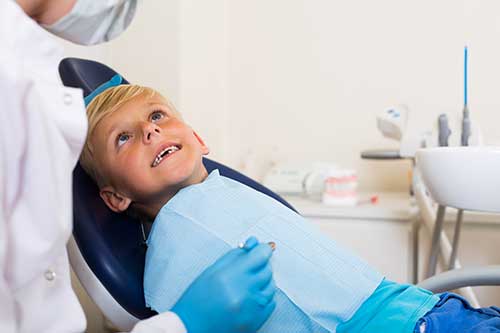The Buzz on Legacy Orthodontics
The Buzz on Legacy Orthodontics
Blog Article
The Of Legacy Orthodontics
Table of ContentsThe 20-Second Trick For Legacy OrthodonticsOur Legacy Orthodontics StatementsThe Best Guide To Legacy OrthodonticsThe Definitive Guide to Legacy OrthodonticsThe Ultimate Guide To Legacy Orthodontics
In addition, we offer flexible treatment routines, versatile repayment choices and an enjoyable, delightful experience.An orthodontist is a dentist educated to identify, avoid, and deal with teeth and jaw irregularities. Orthodontists work with people of all ages, from kids to grownups.
Malocclusion, or misaligned teeth, can lead to oral problems, consisting of dental caries, periodontal condition, and tough or unpleasant eating. Not every person is birthed with straight teeth. If you have a negative bite or huge spaces between your teeth, you may wish to get in touch with a dental expert specializing in orthodontic care.
Legacy Orthodontics - Questions
( Image Debt: DigitalVision/Getty Images) Orthodontists utilize fixed and removable dental devices, like dental braces, retainers, and bands, to transform the setting of teeth in your mouth. Orthodontic therapy is for oral irregularities, including: Crooked teethBite problems, like an overbite or an underbiteCrowded teeth or teeth that are too much apartJaw misalignmentThe goal of orthodontic treatment is to enhance your bite.
While you could assume of orthodontists as mainly for children or teens who need braces, they can correct oral problems at any kind of age. Orthodontists participate in college, dental college, and orthodontic college.
All orthodontists are dental experts, yet not all dental professionals are orthodontists. Orthodontic residency programs provide intensive, concentrated guideline for dental experts. They concentrate on two locations: Exactly how to appropriately and safely move teeth How to appropriately lead development in the teeth, jaw, and faceOnce an orthodontist has actually completed training, they have the alternative to become board certified.
All About Legacy Orthodontics
Misalignment, or malocclusion, is the most common reason people see an orthodontist. It is genetic and is the result of dimension differences between the top and reduced jaw or between the jaw and teeth. Malocclusion causes tooth overcrowding, an askew jaw, or irregular bite patterns. Malocclusion is normally treated with: Your orthodontist attaches steel, ceramic, or plastic square bonds to your teeth.
Some individuals need a headwear to help relocate teeth into line with pressure from outside the mouth. A retainer is a customized device that keeps your teeth in location.
They're most typically made use of on kids. They can develop extra check out here room in the mouth without having to pull teeth. If you have a major underbite or overbite, you may require orthognathic surgical treatment (also called orthodontic surgical treatment) to extend or shorten your jaw. Orthodontists use cables, surgical screws, or plates to sustain your jaw bone.
You might need to see an orthodontist if you have: Crowding or not enough space for every one of your teethOverbite, when your upper teeth come by your bottom teethUnderbite, when your base teeth are too far forwardSpacing or problems with gapsCrossbite, which is when your top teeth fit behind your bottom teeth when your mouth is closedOpen bite or a vertical gap between your front base and top teethMisplaced midline, when the facility of your base and upper teeth do not line up Dealing with a dental malocclusion can: Make biting, chewing, and speaking easierImprove the symmetry of our face and your general appearanceEase pain from temporomandibular joint disordersSeparate your teeth and make them simpler to clean up, aiding prevent tooth degeneration or tooth cavities It's typically a dental expert who first notifications misaligned teeth during a routine exam.
See This Report about Legacy Orthodontics

During your initial orthodontic consultation, you'll likely have: A dental examPhotos taken of your face and smileDental X-raysPanoramic (360 degree) X-rays of your face and headImpressions to produce molds of your teethThese examinations will certainly assist your orthodontist know exactly how to continue with your therapy. orthodontist. An orthodontist is a dental practitioner who's had training to treat your teeth and jaw
Orthodontists may execute surgical procedure, exams,X-rays,and more to assist you attain an extra comfy, healthier smile. An orthodontist is focused on your bite, so something like a broken tooth would certainly be managed by a dentist. Orthodontists are dentists however not all dental professionals are orthodontists. Orthodontists are concentrated on your bite, or the way your teeth fit with each other, and the straightness of your teeth.
Ever questioned just how stars always appear to have flawlessly straightened teeth? Orthodontists are dental professionals who concentrate on remedying abnormalities in the teeth and jaws.
A Biased View of Legacy Orthodontics

While dental braces are one of the most typically identified orthodontic therapy, orthodontists have a diverse toolkit at their disposal. The particular approach chosen relies on the severity of the case, the person's age, and individual preferences. These reliable dental braces use a system of braces bonded to the teeth and linked by cords.
Clear aligners, like Invisalign, are a prominent option for clients looking for a more very discreet therapy choice. These removable trays are personalized to gradually shift the teeth's position. Headwear may be used in conjunction with braces or aligners to use extra targeted forces, especially for fixing jaw discrepancies. In cases of narrow jaws, palatal expanders can be utilized to produce space for proper tooth placement.
Report this page